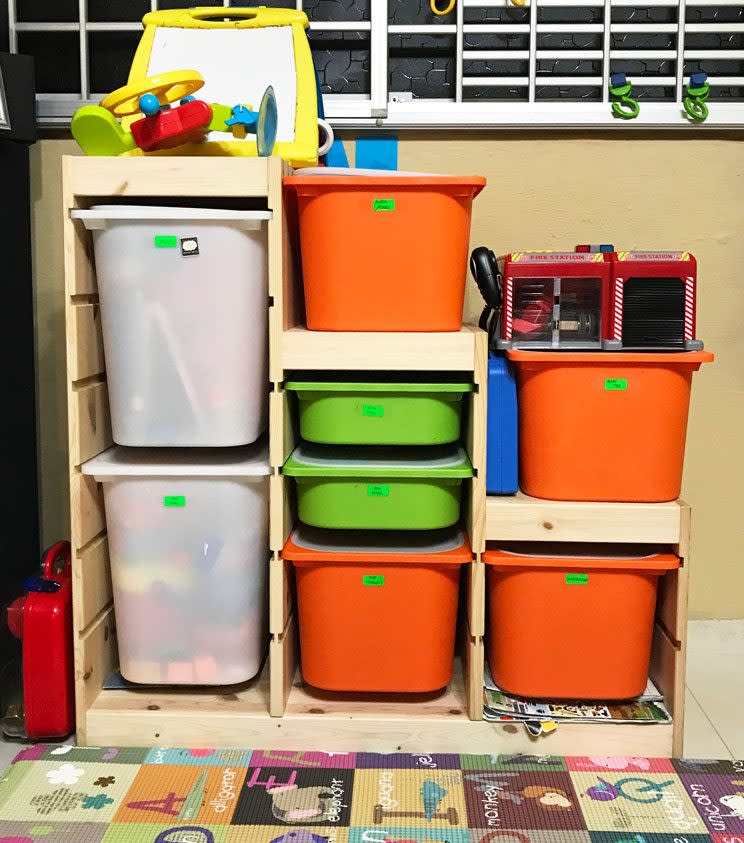With kids' toys, practising a less-is-more approach has many benefits

If you are a parent with young children, you may probably face the same problem as us – it is amazing how many toys two young kids can accumulate over a few short years.
Our other (related) problem is getting the children to put their toys away once they are done playing – toys strewn across our living room floor are a constant source of annoyance (and pain, especially if one of us steps on them).
In line with our recent efforts to de-clutter, toys have been one of the top items on our list to reduce. We went with a somewhat systematic approach by first observing over a month which toys the children kept taking out to play with. At age four, children tend to engage in a lot of imaginative play, and our four-year-old’s (nicknamed “Barnacles”) favourite toys that got a lot of attention were Playmobil and Lego, fire and construction vehicles, as well as his tool box and fire rescue equipment.
We thus kept these toys, and removed all the large remote-control toys that he had played with only for a short period before losing interest, and we felt these were more suitable for older children. It has been several months since those toys were placed in our storeroom and, just as we thought, Barnacles hasn’t even noticed their absence. We’ll probably take them out again when he is a couple of years older.
Also, while we had a lot of toys passed down from older cousins, we found that our 18-month-old (nicknamed “Kwazii”) was quite uninterested in them as he only wanted to play with the toys that his older brother took out to play. Hence, several baby toys also went into the donation box.
Previously, we used to store toys on an open toy shelf, which we thought was great for the ease of choosing toys. However, on hindsight, we found that this did not quite work for our family as our four-year-old is allergic to all types of dust mites, and the toy buckets accumulated dust easily. We thus sold this shelf and finally settled on one of the IKEA toy storage solutions, which we are still very happy with today.

We also came across an interesting book entitled “Simplicity Parenting”, which had a chapter on toys and an apt quote, “A smaller, more manageable quantity of toys invites deeper play and engagement. An avalanche of toys invites emotional disconnect and a sense of overwhelming.” We found this very true – when we had too many toys, our four-year-old would flit through several playthings and on to different pnes, then loudly proclaim that he was bored and didn’t know what else to do.
Today, even after we reduced the amount of toys, with neater toy storage all in one accessible shelf, we find that he is kept occupied longer. He also uses more of his imagination to pretend that a certain toy or character is something or someone else.
When Barnacles was younger, we sometimes used to accede to his requests to buy small toys when we went out shopping. What’s a few dollars to make our child happy, right? However, we later realised that we were creating situations in which he expected to get toys even when it was not a special occasion, and he would even throw tantrums on occasions when we refused him.
In line with our new-found ‘less-is-more’ thinking, we have switched to consistency – we no longer purchase toys when out, unless it is a special occasion such as Children’s day, Christmas or a birthday celebration. We found that this practice worked better as he knows not to expect any toys when out – if we are at a toy store and he pleads with us to buy something, we simply tell him that if he asks to buy one more time, we will leave the store.
The result of our new method? Fewer tantrums (though definitely not zero – he is a four, after all), a smaller number of toys at home, and greater ease of clearing up after play-time. Certainly a win-win situation for us!
Mummy and Daddy Daycare are the pseudonyms of a Singaporean husband and wife who are raising two young boys aged four and one, nicknamed Barnacles and Kwazii from the children’s Octonauts series. Get into the minds of this couple who describe parenthood as a lifetime adventure – you are always learning something new! Whoever said parenting was a walk in the park?
Other articles by Mummy and Daddy Daycare:



